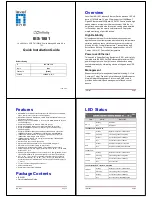
By default, the software tracks hosts on each VLAN port. The explicit tracking feature provides a fast leave
mechanism. Because every IGMPv3 host sends membership reports, a report suppression feature limits the
amount of traffic the switch sends to other multicast-capable routers. When report suppression is enabled,
and no IGMPv1 or IGMPv2 hosts request the same group, the software provides proxy reporting. The proxy
feature builds the group state from membership reports from the downstream hosts and generates membership
reports in response to queries from upstream queriers.
Even though the IGMPv3 membership reports provide a full accounting of group members on a LAN segment,
when the last host leaves, the software sends a membership query. You can configure the parameter last
member query interval. If no host responds before the timeout, the software removes the group state.
IGMP Snooping Querier
When there is no multicast router in the VLAN to originate the queries, you must configure an IGMP snooping
querier to send membership queries.
When an IGMP snooping querier is enabled, it sends out periodic IGMP queries that trigger IGMP report
messages from hosts that want to receive IP multicast traffic. IGMP snooping listens to these IGMP reports
to establish appropriate forwarding.
Currently, you can configure the same SVI IP address for the switch querier and the IGMP snooping querier.
Both queriers will then be active at the same time, and both queriers will send general queries to the VLAN
periodically. To prevent this from happening, ensure that you use different IP addresses for the IGMP snooping
querier and the switch querier.
IGMP Forwarding
The Cisco Nexus device supports snooping based on (S,G)/(*,G) IP addresses. Multicast MAC aliasing does
not apply for Cisco Nexus devices and the snooped entries are programmed in the FIB tables and not in MAC
table.
When a host connected to the switch wants to join an IP multicast group, it sends an unsolicited IGMP join
message, specifying the IP multicast group to join. Alternatively, when the switch receives a general query
from a connected router, it forwards the query to all interfaces, physical and virtual, in the VLAN. Hosts that
want to join the multicast group respond by sending a join message to the switch. The switch CPU creates a
multicast forwarding table entry for the group if it is not already present. The CPU also adds the interface
where the join message was received to the forwarding table entry. The host associated with that interface
receives multicast traffic for that multicast group.
The router sends periodic multicast general queries and the switch forwards these queries through all ports in
the VLAN. Interested hosts respond to the queries. If at least one host in the VLAN wants to receive multicast
traffic, the router continues forwarding the multicast traffic to the VLAN. The switch forwards multicast group
traffic to only those hosts listed in the forwarding table for that multicast group.
When hosts want to leave a multicast group, they can either silently leave, or they can send a leave message.
When the switch receives a leave message from a host, it sends a group-specific query to determine if any
other devices connected to that interface are interested in traffic for the specific multicast group. The switch
then updates the forwarding table for that (S,G) or (*,G) group so that only those hosts interested in receiving
multicast traffic for the group are listed in the forwarding table. If the router receives no reports from a VLAN,
it removes the group for the VLAN from its IGMP cache.
Cisco Nexus 6000 Series NX-OS Layer 2 Switching Configuration Guide, Release 7.x
119
Configuring IGMP Snooping
IGMP Snooping Querier
















































